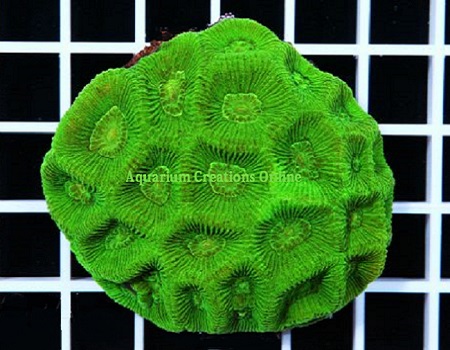The Alien Moon Brain Coral from the waters around Australia is both brilliant and unusual. It is in the large family of brain corals called Favia corals. The neon color makes this one a true reef tank beauty. Excellent for either the experienced OR the beginner aquarist, there's just a couple things to learn for this LPS coral. First they only require moderate (medium level) lighting. Which means expensive lighting is not necessary. Basically any type of bulbs will work from T5 fluorescent to LED's. For higher power level lighting, keep the power low for these beauties. They also do not appreciate strong water movement, keep the water flow at a moderate (medium level) as well. Feed Favia's once or twice a week a micro-plankton food and/or a frozen brine shrimp food.
Difficulty: Easy
Aggressiveness: Favia Brain Corals are aggressive, expanding sweeper tentacles at night well beyond the base. Make sure you leave space between it and its reef aquarium neighbors.
Water-flow: Provide Favia's a moderate water flow. The polyps will remain retracted and under inflated if the water current is too fast, because the large flowing polyps are prone to rip and tear in high or ultra-high current environments.
Lighting:
Requires moderate lighting levels. We recommend a 14-20K color spectrum for best coloration.
Tank Recommendations:
A mature, well-fed live rock/reef environment is what Favia do best with, along with some fish for organic matter production, and dissolved organics.
Diet/Feeding:
Favia corals do not have to be fed but feeding will help speed the growth of this live coral. Feed micro-plankton and/or brine shrimp, twice per week is fine in the evening while its tentacles are visible. For continued good health, calcium, strontium, and other trace elements should be added to the water.
Also Good To Know:
Favia corals contain a large coral skeleton and pull out a good amount of calcium from the saltwater, so use a test kit and watch the levels to ensure that you have enough calcium in the saltwater for good growth. Having a higher than normal calcium level in the aquarium will NOT help the coral grow any faster, but WILL cause other problems like not being able to keep KH at the desired levels. So just keep your calcium level between 400ppm and 420ppm and KH around 8 and all will do well for you. A simpler method is purchasing a calcium reactor. It will help stabilize the calcium level and will also help KH levels in the reef aquarium as well. As far as trace elements, doing regular water changes will help replace the trace elements that the Favia coral may need for good growth.
Propogation:
Favia are fairly easy to propagate via fragging. You can saw off a section on the Favia coral carefully, placing it back where the mother colony lies, and it will grow into an entirely new colony all on its own.
|



